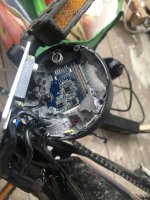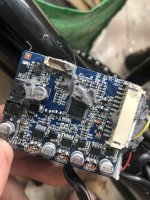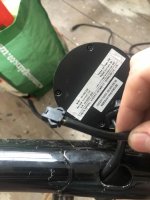Looking for advice on how to add a display to this integrated controller.
I just picked up my first e bike last week and it’s great. It’s a little viking evantage, perfect for getting me to work in the city centre. However, it seems to me like quite a dumb e bike. All it has is an on/off switch, and it works with pas so all you can do is pedal to control it. It’s stuck at full power so it’s like playing Mario kart and getting a red mushroom. I’m constantly speeding up on full power then stopping to coast and slow down, it’s not a natural way of cycling.
There was a model of this bike that was advertised as having a 3 mode pas display, so I’m hoping that I can at least add that. If not then I was hoping there was some system like CA or similar that can help me make this e bike a lot smarter.
The battery and controller are a bottle integrated system, so the controller sits in the bottom of the battery mount. It’s a neat solution that looks better than the usual alu case with lots of connectors poking out. I opened the controller and unfortunately it was potted, so removing all that was not fun. I also proceeded to pull a filter cap off the board which is a pain...my portable soldering iron didn’t have enough beef so I’ll have to fix that at a later date, I think for now I can manage with half it’s filter capacitance, the battery should be pretty clean.
Looking at the board I can see a lot of connections unused. It only has brakes, a switch, motor and pas sensor connected so I’m hoping one of these others could either be for a display control, or allow me to tap into connections to use cycle analyst. Does anyone have any idea of what they could mean? Also there is a spare header on the board that could be another connection, and there’s solder spaces for what looks like Hall effect connections. So I’m hoping somehow I can upgrade this. If all else fails, perhaps someone knows of a controller that has a pcb similar size to this, that I could stuff into the case. I would hate to have to replace the battery and controller considering it’s all neat and tidy the way it is.
Also I noticed when putting it back together that it actually has a spare 3 pin jst connector. Looking at it it looks like that connector goes to the inputs SE0 and SE1, so could that maybe be the display connector I’m looking for? I tried to get in touch with the manufacturer about what display they used but I’ve had no luck getting a reply.
Some photos, anyone have any experience working on this system? The Coyote Energy and the Viking Street Easy used the same ones. Theyre all the same bike just with different branding. I can’t find anything when searching for the controller online. But this spare connector has me hoping.





I just picked up my first e bike last week and it’s great. It’s a little viking evantage, perfect for getting me to work in the city centre. However, it seems to me like quite a dumb e bike. All it has is an on/off switch, and it works with pas so all you can do is pedal to control it. It’s stuck at full power so it’s like playing Mario kart and getting a red mushroom. I’m constantly speeding up on full power then stopping to coast and slow down, it’s not a natural way of cycling.
There was a model of this bike that was advertised as having a 3 mode pas display, so I’m hoping that I can at least add that. If not then I was hoping there was some system like CA or similar that can help me make this e bike a lot smarter.
The battery and controller are a bottle integrated system, so the controller sits in the bottom of the battery mount. It’s a neat solution that looks better than the usual alu case with lots of connectors poking out. I opened the controller and unfortunately it was potted, so removing all that was not fun. I also proceeded to pull a filter cap off the board which is a pain...my portable soldering iron didn’t have enough beef so I’ll have to fix that at a later date, I think for now I can manage with half it’s filter capacitance, the battery should be pretty clean.
Looking at the board I can see a lot of connections unused. It only has brakes, a switch, motor and pas sensor connected so I’m hoping one of these others could either be for a display control, or allow me to tap into connections to use cycle analyst. Does anyone have any idea of what they could mean? Also there is a spare header on the board that could be another connection, and there’s solder spaces for what looks like Hall effect connections. So I’m hoping somehow I can upgrade this. If all else fails, perhaps someone knows of a controller that has a pcb similar size to this, that I could stuff into the case. I would hate to have to replace the battery and controller considering it’s all neat and tidy the way it is.
Also I noticed when putting it back together that it actually has a spare 3 pin jst connector. Looking at it it looks like that connector goes to the inputs SE0 and SE1, so could that maybe be the display connector I’m looking for? I tried to get in touch with the manufacturer about what display they used but I’ve had no luck getting a reply.
Some photos, anyone have any experience working on this system? The Coyote Energy and the Viking Street Easy used the same ones. Theyre all the same bike just with different branding. I can’t find anything when searching for the controller online. But this spare connector has me hoping.






